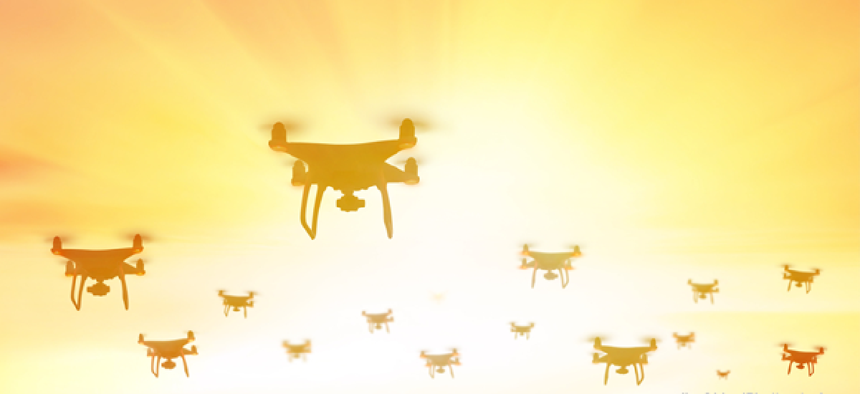Laying the foundation for drone swarms


Connecting state and local government leaders
DARPA wants technologies and tactics to manage drone swarms in diverse, evolving urban situations.
A single bee is an annoyance. A swarm of bees is terrifying.
The Defense Advanced Research Projects Agency is looking to bring this strength-in-numbers philosophy to unmanned systems as it invests in technologies to make drone swarms a reality.
The agency's Offensive Swarm-Enabled Tactics (OFFSET) program aims to design, develop and demonstrate a game-based swarm system architecture for operationally relevant swarm tactics for over 100 robots in urban areas over six-hour missions. Specifically, DARPA plans an ecosystem that includes an advanced human-swarm interface so users can monitor and direct drones; a real-time, networked virtual environment supporting a physics-based, swarm tactics game; and a community-driven swarm tactics exchange.
“We anticipate achieving a deeper understanding of how large numbers of increasingly autonomous air and ground robots can be leveraged to benefit urban warfighters,” said Timothy Chung, DARPA program manager. “If we’re successful, this work could also bring entirely new scalable, dynamic capabilities to the battlefield, such as distributed perception, robust and resilient communications, dispersed computing and analytics and adaptive collective behaviors.”
OFFSET will use six-month long sprints focused on different areas related to swarm technology.
The first sprint features a swarm of 50 unmanned systems -- both on the ground and in the air – that are assigned to “prepare an area for further operations by small unit forces,” Chung said in a video describing the efforts. This includes reconnaissance, the ability to find entry and exit points and helping to construct a perimeter.
Roughly every six months, DARPA plans to solicit proposals from potential sprinters, with each swarm sprint focusing on one of five thrust areas: swarm tactics, swarm autonomy, human-swarm teaming, virtual environment and physical testbed.
Raytheon BBN Technologies and Northrop Grumman have been contracted to build both the virtual and physical environments for this program that will test the abilities of “sprinters” who respond to solicitations from DARPA.
DARPA's investment in robot swarms is part of the military's shift away from larger legacy aircraft to more cutting-edge technologies, according to Dan Gettinger, the co-director of the Center for the Study of the Drone at Bard College.
The investment in autonomy, teaming and swarm technologies has grown from $211 million in fiscal 2013 to a budgeted $457 million in 2018, according to an analysis authored by Gettinger.
While drone swarms may not be at the point of operational readiness, there have been some successes.
The Office of Naval Research was able to demonstrate swarming technology in 2016 with autonomous boats that worked collaboratively on patrol missions in Virginia. The largest drone swarm to date, though, is claimed by China when a state-owned company in June demonstrated 119 flying drones. One goal of OFFSET is to bring this number to 250 or more.




